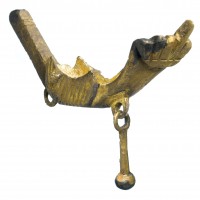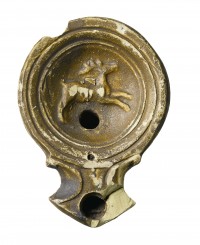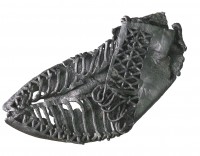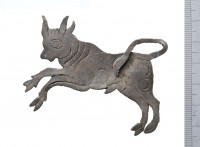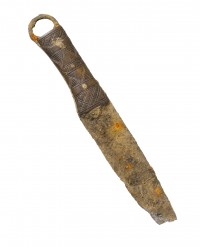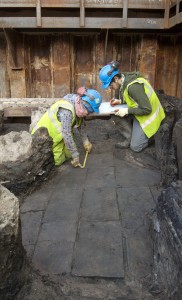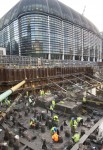 A six-month excavation by Museum of London Archaeology at the construction site of Bloomberg’s future European headquarters in the center of London has revealed layer upon beautifully-preserved layer of Roman habitation from the earliest days in 40 A.D. to the collapse of Roman rule in the 5th century. Just a few yards from the Thames and waterlogged by the Walbrook River, one of London’s famous “lost rivers” that disappeared under the city when they were diverted into culverts to make way for development, the three acre site is replete with organic remains in incredible condition. Entire streets have survived, as have the remains of shoulder-high wooden
A six-month excavation by Museum of London Archaeology at the construction site of Bloomberg’s future European headquarters in the center of London has revealed layer upon beautifully-preserved layer of Roman habitation from the earliest days in 40 A.D. to the collapse of Roman rule in the 5th century. Just a few yards from the Thames and waterlogged by the Walbrook River, one of London’s famous “lost rivers” that disappeared under the city when they were diverted into culverts to make way for development, the three acre site is replete with organic remains in incredible condition. Entire streets have survived, as have the remains of shoulder-high wooden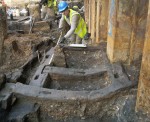 walls, extensive wood foundations, complex waste drainage systems, a deep wooden well and a wooden door that is the second Roman wood door ever discovered in London. The extent of preservation has inspired archaeologists to dub this find “the Pompeii of the North.”
walls, extensive wood foundations, complex waste drainage systems, a deep wooden well and a wooden door that is the second Roman wood door ever discovered in London. The extent of preservation has inspired archaeologists to dub this find “the Pompeii of the North.”
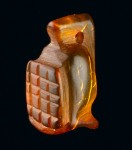 In addition to the structural remains, the site has proven a motherlode for artifacts as well. A team of 60 archaeologists has excavated about 3,500 tons of soil (that’s 21,000 wheelbarrows full) by hand to find more than 10,000 objects, the largest group of small finds ever recovered in a single excavation in London. The collection includes hundreds of leather shoes, a straw basket, more than 100 fragments of writing tablets, textiles, an amber amulet shaped like a gladiator helmet, a mysterious leather piece
In addition to the structural remains, the site has proven a motherlode for artifacts as well. A team of 60 archaeologists has excavated about 3,500 tons of soil (that’s 21,000 wheelbarrows full) by hand to find more than 10,000 objects, the largest group of small finds ever recovered in a single excavation in London. The collection includes hundreds of leather shoes, a straw basket, more than 100 fragments of writing tablets, textiles, an amber amulet shaped like a gladiator helmet, a mysterious leather piece richly decorated with a scene of a gladiator battling mythical creatures, a cavalry harness with clappers that jingle when a horse moves, a group of high-quality pewter vessels that were thrown down a well probably for ritual purposes, and the greatest number of fist and phallus good luck charms ever found at one site.
richly decorated with a scene of a gladiator battling mythical creatures, a cavalry harness with clappers that jingle when a horse moves, a group of high-quality pewter vessels that were thrown down a well probably for ritual purposes, and the greatest number of fist and phallus good luck charms ever found at one site.
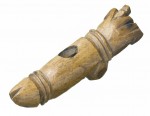 Archaeologists were able to dig far deeper than usual due to the scale of the planned construction. The Bloomberg Place development at Great Queen Street will be a major high-rise that requires attendant deep foundations. Thus experts had the rare opportunity to dig 40 feet below street level to the first Roman settlement layer. The location is also of huge significance. This neighborhood was the bed of the Walbrook, the very center of Roman Londinium where, on the east bank of the tributary, the Romans built a port, the governor’s palace and a temple of Mithras.
Archaeologists were able to dig far deeper than usual due to the scale of the planned construction. The Bloomberg Place development at Great Queen Street will be a major high-rise that requires attendant deep foundations. Thus experts had the rare opportunity to dig 40 feet below street level to the first Roman settlement layer. The location is also of huge significance. This neighborhood was the bed of the Walbrook, the very center of Roman Londinium where, on the east bank of the tributary, the Romans built a port, the governor’s palace and a temple of Mithras.  The Mithraeum was unearthed in 1954 by Welsh archaeologist William Francis Grimes, director of the Museum of London, after Victorian buildings damaged by bombs in World War II were demolished for the construction of an office building.
The Mithraeum was unearthed in 1954 by Welsh archaeologist William Francis Grimes, director of the Museum of London, after Victorian buildings damaged by bombs in World War II were demolished for the construction of an office building.
The discovery of the Mithraeum was the most important discovery of 20th century London. Crowds flocked to see the ruins and a public campaign to save them from threatened destruction led to their being relocated down the road to Temple Court where they still stand today. Researchers  therefore had high expectations that the Bloomberg Place dig would result in archaeological finds of great significance. Obviously these were more than met. They even found a new section of the Temple of Mithras.
therefore had high expectations that the Bloomberg Place dig would result in archaeological finds of great significance. Obviously these were more than met. They even found a new section of the Temple of Mithras.
The artifacts are being cleaned and conserved at the Museum of London. The organic elements will be freeze-dried to preserve them. It’s not clear to me how the extensive city layers will be handled, but the construction project has all along planned to return the Mithraeum to its original site and integrate it into a public display. Now they just have a lot more to display than they planned.
The London Museum of Archaeology was kind enough to allow me access to their Dropbox account so of course I took everything and ran. Enjoy the media dump of awesomeness.
